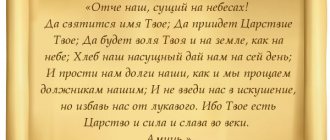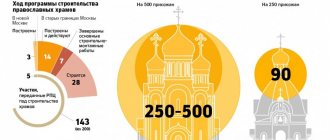Moscow, 07/24/2021, 00:48:51, editorial office of FTimes.ru, author Tatyana Orlonskaya.
In Russia, the Church is not funded by the state, but it enjoys a number of tax benefits. But in Europe there are a number of states that have a so-called “tax in favor of the church.”
In the European Union, the practice of financing churches is very common. The most popular model of assistance is the church tax, and in 6 EU countries the state sponsors the church on an ongoing basis. Among them are Belgium, the Czech Republic, Greece, Luxembourg and Slovakia.
What is church tax and who pays it?
Church tax is a tax on the income of individuals for financing through the state of the religious denomination of which the taxpayer is a member. There are two main models: mandatory income tax for all persons who officially confirm their membership in a particular association. This is how the system works in Germany, Austria, Croatia, Sweden, Denmark, Finland and Iceland, as well as in some cantons of Switzerland.
Italy and Spain, as well as Holland and Hungary, have a different taxation system. It is based on the voluntary transfer of a percentage of the tax to the church.
The percentage of such tax varies and ranges from 0.004% to 10%. All believers pay it, and those who refuse are excommunicated from the church.
Notes
- www.openspace.ru/article/504 I paid the tax - and rest assured!
- [www.cogbyte.de/project/1062-1077-1088-1082.212.0.html?&L=2 Church tax]
- [lenta.ru/news/2016/04/20/tax_on_religion/ A Bundestag deputy proposed levying a religious tax on Muslims], Lenta ru
(April 20, 2016). - [lenta.ru/news/2016/04/13/germanyislam/ In Germany they proposed banning foreign funding of mosques], Lenta ru
(April 13, 2016). - [www.km.dk/kirkeministeriet/om-ministeriet/ Om ministeriet]
- [www.km.dk/kirke/folkekirken/oekonomi/kirkeskat/ Kirkeskat]
- [www.skatteverket.se/privat/skatter/arbeteinkomst/vadblirskatten/avgifttillandratrossamfund.4.18e1b10334ebe8bc80005629.html Avgift till andra trossamfund i skattebeskedet | Skatteverket]
- [www.youtube.com/watch?v=U3YA-1mSh0I Typical Swedish Christianity – YouTube]
- [www.livingchurch.org/church-sweden-nonbelievers Church of Sweden's Nonbelievers | The Living Church (Church of Swedish Non-Believers)]
- [lenta.ru/news/2012/09/20/katholiken/ Lenta.ru: World: In Germany, church tax defaulters will be excommunicated]
- [www.rg.ru/2012/10/17/germany.html In Germany, taxes for the church are collected by the state - Anna Rose - Rossiyskaya Gazeta]
- [www.nsad.ru/articles/cerkovnyj-nalog-ili-dobrovolnoe-pozhertvovanie Church tax or voluntary donation? | Orthodox magazine "Neskuchny Sad"]
- [www.swissinfo.ch/rus/%D1%86%D0%B5%D1%80%D0%BA%D0%BE%D0%B2%D0%BD%D1%8B%D0%B9-%D0%BD %D0%B0%D0%BB%D0%BE%D0%B3-%D1%80%D0%B0%D1%81%D1%81%D0%BE%D1%80%D0%B8%D0%BB- %D0%BA%D0%B0%D1%82%D0%BE%D0%BB%D0%B8%D0%BA%D0%BE%D0%B2-%D1%88%D0%B2%D0%B5% D0%B9%D1%86%D0%B0%D1%80%D0%B8%D0%B8/36497138 Church tax quarrels Catholics in Switzerland]
Percentage of CN in different countries, table
| Church tax rate | Voluntary donations of a portion of income tax | No church tax – direct government subsidies | Separation of state and church property |
| Austria (1.1%) | |||
| Denmark (up 1.51%) | Spain (0.5239%) | Belgium | France |
| Finland (1-2%) | Holland (1-3%) | Czech | Ireland |
| Germany (8-9%) | Hungary (1%) | Greece | Portugal |
| Switzerland (up to 2.3%) | Italy (0.8%) | Luxembourg | |
| Sweden (up to 2%) | Slovakia |
CHURCH TAX
See what “CHURCH TAX” is in other dictionaries:
Church tax in Germany - Church tax (German: Kirchensteuer) is a tax levied by religious communities on their members and used to finance the expenses of the community.
In Germany, church tax is levied by the financial administration (German: Finanzamt)... ... Wikipedia GEORGIAN ORTHODOX CHURCH. PART I - [Georgian Apostolic Autocephalous Orthodox Church; cargo. საჟართველოს მართლმადიდებელი ეკლესია], Local Church extending jurisdiction over the territory of Georgia, as well as their flock in the border regions of Turkey, Azerbaijan and... ... Orthodox Encyclopedia
Finland* — Contents: I. Physical essay. II. Population. III. Economic review. IV. Finance. V. Administration and judicial system. VI. Finnish troops and conscription. VII. Education. VIII. Science, art, printing and social life. IX. Church. X... Encyclopedic Dictionary F.A. Brockhaus and I.A. Efron
Finland - I Contents [For the history of Finland, the history of literature, language and mythology, see respectively. sections.]. I. Physical sketch. II. Population. III. Economic review. IV. Finance. V. Administration and judicial system. VI. Finnish troops and conscription. VII.... ... Encyclopedic Dictionary F.A. Brockhaus and I.A. Efron
Evangelical Lutheran Church of Finland - Turku Lutheran Cathedral Denomination Protestantism ... Wikipedia
BYZANTINE EMPIRE. PART I - [East. Roman Empire, Byzantium], Late Antique and Middle Ages. Christ state in the Mediterranean with its capital in K field in the IV middle. XV century; the most important historical center for the development of Orthodoxy. Unique in its richness is Christ. culture created in ... Orthodox Encyclopedia
INDIA - [Republic of India; Hindi Bharat Ganarajya; English Republic of India], state in South. Asia. It is washed by the waters of the Indian Ocean: in the west by the Arabian Sea, in the southwest by the Laccadive Sea, in the east by the Bay of Bengal; in the south is the Mannar Hall. and Polksky... ... Orthodox Encyclopedia
Revolution of 1917 in Russia - See also: Revolution of 1905 1907 in Russia Change of power in Russia in 1917 1918 ... Wikipedia
GEORGIAN EXARCHATE OF THE RUSSIAN ORTHODOX CHURCH - [Georgian Exarchate of the Holy Synod of the Orthodox Russian Church] (June 30, 1811 July 10, 1917; until February 21, 1920 Caucasian Exarchate of the Russian Orthodox Church), orthodox. The Church on the territory of Georgia after its entry into the Russian Empire and abolition... ... Orthodox Encyclopedia
Great Britain - I Contents: A. Geographical outline: Position and boundaries Surface structure Irrigation Climate and natural products Space and population Emigration Agriculture Cattle breeding Fishing Mining Industry Trade... ... Encyclopedic Dictionary F.A. Brockhaus and I.A. Efron
Source
Why American priests don't pay taxes
Under United States law, churches do not pay federal, state or local taxes, and their pastors are also exempt. An exception to the payment of income tax is the religious services they provide. However, if for religious reasons a clergyman in America hates to pay taxes, then by writing a corresponding statement to the tax service, clergymen have the right to relieve themselves of this “burden.”
The US tax authorities do not require spiritual leaders to file tax returns or force them to report expenses, as is the case with civil non-profit organizations and charities.
Excerpt describing the Church tax
Princess Marya, straining all her attention, looked at him. The comic labor with which he moved his tongue forced Princess Marya to lower her eyes and with difficulty suppress the sobs rising in her throat. He said something, repeating his words several times. Princess Marya could not understand them; but she tried to guess what he was saying and repeated the questioning words he said to the elephant. “Gaga – fights... fights...” he repeated several times. There was no way to understand these words. The doctor thought that he had guessed right, and, repeating his words, asked: is the princess afraid? He shook his head negatively and repeated the same thing again... “My soul, my soul hurts,” Princess Marya guessed and said. He hummed affirmatively, took her hand and began to press it to various places on his chest, as if searching for the real place for her. - All thoughts! about you... thoughts,” he then said much better and more clearly than before, now that he was sure that he was understood. Princess Marya pressed her head against his hand, trying to hide her sobs and tears. He moved his hand through her hair. “I called you all night...” he said. “If only I knew...” she said through tears. – I was afraid to enter. He shook her hand. – Didn’t you sleep? “No, I didn’t sleep,” said Princess Marya, shaking her head negatively. Unwittingly obeying her father, she now, just as he spoke, tried to speak more with signs and seemed to also be moving her tongue with difficulty. - Darling... - or - friend... - Princess Marya could not make out; but, probably, from the expression of his gaze, a gentle, caressing word was said, which he never said. - Why didn’t you come? “And I wished, wished for his death! - thought Princess Marya. He paused. “Thank you... daughter, friend... for everything, for everything... forgive... thank you... forgive... thank you!..” And tears flowed from his eyes. “Call Andryusha,” he suddenly said, and something childishly timid and distrustful was expressed in his face at this demand. It was as if he himself knew that his demand made no sense. So, at least, it seemed to Princess Marya. “I received a letter from him,” answered Princess Marya. He looked at her with surprise and timidity. - Where is he? - He is in the army, mon pere, in Smolensk. He was silent for a long time, closing his eyes; then in the affirmative, as if in response to his doubts and to confirm that he now understood and remembered everything, he nodded his head and opened his eyes. “Yes,” he said clearly and quietly. - Russia is dead! Ruined! - And he began to sob again, and tears flowed from his eyes. Princess Marya could no longer hold on and cried too, looking at his face. He closed his eyes again. His sobs stopped. He made a sign with his hand to his eyes; and Tikhon, understanding him, wiped away his tears. Then he opened his eyes and said something that no one could understand for a long time, and finally only Tikhon understood and conveyed it. Princess Marya looked for the meaning of his words in the mood in which he spoke a minute before. She thought that he was talking about Russia, then about Prince Andrei, then about her, about his grandson, then about his death. And because of this she could not guess his words. “Put on your white dress, I love it,” he said. Realizing these words, Princess Marya began to sob even louder, and the doctor, taking her by the arm, led her out of the room onto the terrace, persuading her to calm down and make preparations for departure. After Princess Marya left the prince, he again started talking about his son, about the war, about the sovereign, twitched his eyebrows angrily, began to raise a hoarse voice, and the second and final blow came to him. Princess Marya stopped on the terrace. The day had cleared up, it was sunny and hot. She could not understand anything, think about anything and feel anything except her passionate love for her father, a love that, it seemed to her, she did not know until that moment. She ran out into the garden and, sobbing, ran down to the pond along the young linden paths planted by Prince Andrei. - Yes... I... I... I. I wanted him dead. Yes, I wanted it to end soon... I wanted to calm down... But what will happen to me? “What do I need peace of mind when he’s gone,” Princess Marya muttered aloud, walking quickly through the garden and pressing her hands on her chest, from which sobs were convulsively escaping. Walking around the garden in a circle that led her back to the house, she saw M lle Bourienne (who remained in Bogucharovo and did not want to leave) and an unfamiliar man coming towards her. This was the leader of the district, who himself came to the princess in order to present to her the necessity of an early departure. Princess Marya listened and did not understand him; she led him into the house, invited him to have breakfast and sat down with him. Then, apologizing to the leader, she went to the door of the old prince. The doctor with an alarmed face came out to her and said that it was impossible. - Go, princess, go, go! Princess Marya went back into the garden and sat down on the grass under the mountain near the pond, in a place where no one could see. She didn't know how long she was there. Someone's running female steps along the path made her wake up. She got up and saw that Dunyasha, her maid, who was obviously running after her, suddenly, as if frightened by the sight of her young lady, stopped. “Please, Princess... Prince...” Dunyasha said in a broken voice. “Now, I’m coming, I’m coming,” the princess spoke hastily, not giving Dunyasha time to finish what she had to say, and, trying not to see Dunyasha, she ran to the house. “Princess, God’s will is being done, you must be ready for anything,” said the leader, meeting her at the front door. - Leave me. It is not true! – she angrily shouted at him. The doctor wanted to stop her. She pushed him away and ran to the door. “Why are these people with frightened faces stopping me? I don't need anyone! And what are they doing here? “She opened the door, and the bright daylight in this previously dim room terrified her. There were women and a nanny in the room. They all moved away from the bed to give her way. He was still lying on the bed; but the stern look of his calm face stopped Princess Marya at the threshold of the room. “No, he’s not dead, that can’t be! - Princess Marya said to herself, walked up to him and, overcoming the horror that gripped her, pressed her lips to his cheek. But she immediately pulled away from him. Instantly, all the strength of tenderness for him that she felt in herself disappeared and was replaced by a feeling of horror at what was in front of her. “No, he is no more! He is not there, but there is right there, in the same place where he was, something alien and hostile, some terrible, terrifying and repulsive secret... - And, covering her face with her hands, Princess Marya fell into the arms of the doctor who supported her. In the presence of Tikhon and the doctor, the women washed what he was, tied a scarf around his head so that his open mouth would not stiffen, and tied his diverging legs with another scarf. Then they dressed him in a uniform with orders and placed the small, shriveled body on the table. God knows who took care of this and when, but everything happened as if by itself. By nightfall, candles were burning around the coffin, there was a shroud on the coffin, juniper was strewn on the floor, a printed prayer was placed under the dead, shriveled head, and a sexton sat in the corner, reading the psalter.
Does the Russian Orthodox Church pay tax?
Many people are interested in the question of whether the Russian Orthodox Church pays taxes to the treasury. The clergy answer this way: The Russian Orthodox Church is a non-profit enterprise and lives autonomously on its own funds. Of course, she does not have the right to conduct any commercial activities and make a profit. The income of the church is not official and is not reflected in official documentation.
But the Russian Orthodox Church still pays taxes, although it enjoys some benefits. There are only two of them: The first is an income tax benefit. This includes sales of scarves and wedding rings. But donations and distribution of religious literature are not subject to income tax.
A VAT exemption is also applied for religious items, according to the list approved by the Decree of the Government of the Russian Federation in March 2001. As you know, the sale of spiritual literature, candles, incense, icons, various church items, crosses, including some jewelry, audio and video discs, etc. are not subject to VAT.
The entire structure of the church is such that it allows it to take budget funds from the state and exist completely autonomously. From their own treasury they provide not only the work of the temples, but also support the ministers.
Comments
Church tithes in historical context
In church life today there is an urgent need to find other ways to provide material support for Orthodox parishes.
One of the negative consequences of trade in the Church is “reputational losses”
It is no secret that the lack of sufficient financial resources to ensure the functioning of the parish (payment of utilities - electricity, water supply, heating, etc., material support for the clergy and clergy, expenses for charitable activities, etc.) forces many rectors to look for a source of financing in trade various goods, not only far from the actual spiritual goals (for example, food), but also completely dubious and even harmful to the soul (“Orthodox” souvenirs with a bias towards amulets, etc.). Examples of such products were given in previous articles by the authors. One of the negative consequences of such too extensive trade in the Church is, in modern language, “reputational losses” and frequent reproaches that “the Church is a business.”
An alternative to this method of financing a church organization would be a return to church tithes in one form or another. In 2019, the authors already had the opportunity to talk about this on Radio Radonezh, but this complex topic is worth considering more thoroughly in the article.
Tithe in the Bible
In ancient Israel there was a rather complex system of taxes for the maintenance of the temple, its servants and charitable purposes. Israel was ordered to annually bring the firstfruits to the “house of the Lord” (cf. Ex. 23, 16, 19; 34, 26; Deut. 26, 1–11), to allocate tithes for the maintenance of the Levites (cf. Num. 18, 19–21 ), who from their share gave to the priests “tithe of tithe” (cf. Num. 18:26–29). Every 3rd year the tithe was given not to the temple, but to the Levites, strangers, orphans and widows (cf. Deut. 14:27-29).
Since Israel received the land and its fruits from the Lord (cf. Deut. 26:8-10; Ps. 23:1), the prophet Malachi called non-payment of tithes and refusal of offerings to the “house of the Lord” “robbing” God (Malachi 3 , 8–10).
According to Josephus, in Israel it was necessary to pay two tithes annually, and a third in the third and sixth years of the seven-year cycle. Thus, during this cycle, 16 dessiatines were separated, which amounted to more than 22% of the population’s annual income and was not an easy burden for them[1].
In the New Testament, Our Lord Jesus Christ does not abolish the tithe, but emphasizes the main thing, which is “judgment, mercy and faith” (Matthew 23:23). Condemning the scribes and Pharisees for the fact that they tithe even “mint, anise and cumin,” but do not fulfill the main thing in the Law, the Lord says: “This should have been done and not forsaken” (Matthew 23, 23; Luke 11 , 42).
A.P. Lopukhin in his Explanatory Bible explains this passage from the Gospel as follows:
“The direct meaning [of Christ’s words] is this: it was necessary to observe the requirements of judgment (justice), mercy and faith, without neglecting to pay tithes.”
According to the interpretation of blessed. Theophylact of Bulgaria, tithes must be understood allegorically:
“...every teacher must demand tithes from the people, that is, demand from the ten senses (five bodily and five mental) judgment, mercy and faith. “This should have been done,” says the Lord, not thereby commanding the tithe of vegetables, but eliminating the pretext for the accusation that He teaches contrary to the law of Moses.”
It is worth remembering that, in fulfillment of the Law, the Lord Himself, through the Apostle Peter, gives taxes to the “dirachm collectors” for the temple, although He, as the Son of God, is free from this, just as the royal “sons are free” from taxes to the earthly king (Matthew 17: 24–27 ).
At the same time, sending His disciples to preach, Christ commands them not to stock up on money or things (clothes, shoes), but to “live from the gospel” (1 Cor. 9:14), i.e. at the expense of those who host them: to live and eat in the house where they will stay, “for the worker is worthy of reward for his labors” (Luke 10:7. Wed. Matthew 10:10).
It is these words of the Savior that the Apostle Paul refers to in support of his right to enjoy material support from the Corinthian community (1 Cor. 9:1-14), which he, unlike other preachers, voluntarily refused in order to receive greater rewards from God by preaching the gospel “ in Christ freely" (1 Cor. 9:15-18). In support of this right, the apostle also refers to the Old Testament institutions:
“Do you not know that those who officiate are fed from the sanctuary? That those who serve the altar take a share from the altar?” (1 Cor. 9, 13. Wed. Deut. 18, 1–8; 25, 4).
The right of “worthy leading elders” (especially those who labor “in word and doctrine”) to material support from the community is directly affirmed by the Apostle Paul in his letter to Timothy:
- “For the Scripture says: “Do not muzzle an ox while it is threshing” [Deut. 18, 25, 4];
- “The worker is worthy of his reward” [cf. OK. 10, 7; 1 Cor. 9, 9]" (1 Tim. 17-18).
The apostle also wrote about the need to help the poor and poor communities (1 Cor. 16:1; Gal. 2:10).
After Pentecost, Christian communities in the diaspora (in Rome, Antioch, Macedonia, Achaia, Galatia, etc.) gathered voluntarily (“according to the disposition of the heart ... not under compulsion” [2 Cor. 9, 7]) and feasible (as much as “the state allows” [1 Cor. 16, 2]) alms for the transfer of the Jerusalem Church, which is repeatedly reported in the Apostle (Acts 11, 27-30; 24, 17; Rom. 15, 25-28; 1 Cor. 16, 1-4; 2 Cor. 8–9; Gal. 2:10).
At the same time, the Apostle Paul believed that Gentile Christians are “debtors” to Jewish Christians: “For if the Gentiles have become partakers of their spiritual things, they must also serve them in bodily things” (Rom. 15:27). Interpreters emphasize that the Jerusalem Christians were in a more constrained psychological and material situation than the faithful in the dispersion, due to the strong pressure of the Jewish environment on their fellow Christians, who “deviated” from the “faith of their fathers” (and in fact fulfilled it). However, in the collection of alms from all Christian communities of the Oikumene for the Mother Church of Jerusalem, one cannot help but see an analogy with the collection of Jewish taxes for the Temple of Jerusalem from all the Jews of Palestine and the Diaspora.
In the New Testament we find neither the abolition of tithes nor their establishment for Christians in the form of a flat tax
Thus, in the New Testament we find neither an explicit abolition of the tithe established by the Law of Moses, nor its establishment for Christians in the form of a mandatory flat tax, as was the case in the Old Testament. In the letters of the Apostle Paul, the emphasis is on alms given to those in need out of Christian love for them, and there is no law for love. Such alms are not “old” tithes, but a gift from a loving heart. At the same time, the apostle does not call someone to self-deprivation, but encourages donations to charity according to their wealth (2 Cor. 8:11-15), for “it is not required that there should be relief for others and heaviness for you, but that there should be equality” (2 Cor. 8:13).
At the same time, both our Lord Jesus Christ (Matt. 10:10; Luke 10:7) and the Apostle Paul (1 Cor. 9:1-14; 1 Tim. 17-18) say that evangelists of the Gospel and clergy has the right to receive material support from his flock.
Tithes in the early Church and in church law
In the early Church (1st–3rd centuries) there were offerings in favor of its ministers and needy members of the community. The responsibilities of the Christian community to support the clergy and help the poor are discussed in most detail in such a well-known and authoritative church canonical monument as the “Apostolic Decrees.”
The Apostolic Constitutions are a compilation of liturgical-canonical monuments from the 1st–3rd centuries, but also contain some original texts. In the “Resolutions” the idea is consistently conveyed that the New Testament priesthood, as “serving the altar” like the Old Testament priesthood, “is fed from the altar” and carries out charitable activities.
- “Therefore, since you [the clergy – Author] bear the burden, it is necessary that you be the first to enjoy the fruits and distribute them to those in need...”;
- “the portions, tithes and firstfruits are to the high priest Christ and his servants” (II.25)[2].
According to this monument, the Lord freed Christians from sacrificing animals to Him, however
- He “has not released you from the contributions you lent to the priests, or from charity to the needy.”
- “You will do so as the Lord has decreed, and you will give to the priest what is due to him - the firstfruits of the threshing floor and the winepress and offerings for sins, as a mediator between God and those in need of cleansing and intercession; for it is fitting for you to give, and for him to distribute, because he is a steward and ruler of church affairs” (II.35)[3].
- “Do not appear before the priests empty-handed, but continually offer your voluntary gifts” (II.36)[4].
In addition to voluntary offerings, the “Resolutions” prescribe that firstfruits, tithes, and other obligatory portions be brought for the maintenance of the clergy. As a rule, this was done through the bishop, as the head of the local community.
“So, you, brothers, must offer your sacrifices, that is, offerings, to the bishop, as to the high priest, either personally or through the deacons. However, not only sacrifices, but also firstfruits, and tithes, and freewill gifts you bring to him...” (II.27)[5].
The canon prescribes to honor the bishop,
“giving to him, as to the priest of God, your firstfruits, your tithes, your portions and your gifts, the firstfruits of bread, wine, oil, apples, wool, and all that the Lord God provides you with...” (II.34)[6].
Some canons directly indicate the obligation of believers to separate part of the fruits for the maintenance of priests:
“Give every firstfruits of the winepress, the threshing floor, and oxen and sheep to the priests, so that what is stored in your storehouses and the growth of your land may be blessed...” (VII.29)[7].
To help those in need, it is prescribed to bring both voluntary offerings (II.25; III.4)[8] and tithes (VII.29; VIII.30)[9]:
“Give every tithe to the orphan and the widow, the needy and the stranger” (VII.29).
The bishop is instructed to fairly dispose of “the tithes and first-fruits given according to the commandment of God”:
“Let [the bishop] distribute voluntary offerings for the poor correctly to orphans, widows, suffering and poor strangers, as he who has to give an account of this to God...” (II.25)[10].
It should be noted that in subsequent centuries, the “Apostolic Decrees” in their canonical part did not cause objections, although in their doctrinal part discrepancies were seen with the later teaching of the Church. Therefore, the fathers of the Fifth-Sixth Council of Trulla (691–692) with their second Rule “for the edification and protection of the most Christian flock, these Clementine decrees prudently postponed”[11].
However, from the “Apostolic Decrees”, 85 Rules of the Holy Apostles were included in the canonical code of the Orthodox Church, including several Rules relating to the maintenance of clergy by members of the church community.
Thus, Rule 3 prohibits bringing any food to the altar except wine and bread, as well as “new grapes or grapes at the appropriate time”[12]. And rule 4[13], according to the explanation of the Orthodox canonist, priestly confessor Nicodemus (Milos),
“renewing the instructions of the previous one, he commands that the firstfruits of every fruit be sent to the bishop and presbyters so that this will be the content both for them and for everyone else who is in the service of the church.”
These firstfruits - voluntary offerings of the faithful - “were the only source of support for the clergy in the early times of the Church,” notes the interpreter[14].
Rule 41 prescribes
“for the bishop to have power over the church estate”, “so that he manages everything according to his authority, and gives to those who demand through the presbyters and deacons... in the same way (if necessary) he himself borrows for the necessary needs of his own and the strangely accepted brethren... For the law of God has decreed that those who serve the altar they eat from the altar...”[15].
As Bishop Nikodim (Milosz) writes, in the early Church, “as long as there was a community of church property,” all the property of any local Christian community “consisted of the offerings of the faithful during worship.” The head of the community, the bishop, divided these offerings into three parts:
- “for the needs of worship and maintaining the premises for the latter”;
- “for the maintenance of oneself and the clergy”;
- “to help poor church members”[16].
Beginning in 315, by decree of Emperor Constantine the Great, additional funds from the state treasury began to be allocated to help support the clergy[17].
The author names the following sources of content for the parish clergy[18]:
- monetary reward, mentioned in apostolic times;
- a piece of land “the fruits of which it has the right to enjoy”;
- “epithrachelian income” (payment for services, etc.);
- “established offerings from the parishioners from the fruits of the earth or from animals.”
Regarding the latter, Bishop Nicodemus writes:
“A common and very ancient source of maintenance for the parish clergy is the collection, that is, what is annually given by the parishioners to the priest from the fruits of the earth or livestock. We also find this kind of collection for the benefit of the clergy in the Old Testament Church.”[19]
The New Testament Church inherited this principle. The most ancient ecclesiastical legal monuments speak about the annual offering of tithes from the fruits of the earth “in favor of the church and clergy[20].”
In the Western Church, from this arose the doctrine of compulsory tithing, which developed in Roman Catholic church legislation starting in the 6th century, and is preserved to this day in many Catholic and Protestant countries.
“There is nothing of the kind in the general Eastern Church legislation,” writes Bishop. Nicodemus, - but it was only left to the faithful to give to their clergy from the fruits of the earth according to their diligence, as much as they could, without determining the quantity[21].
Tithe in Russia
In Rus', tithes in favor of the Church were paid only by state authorities, starting with St. equal to Vel. Prince Vladimir - the Baptist of Rus'.
“The fundamental difference between the tithe that existed in Rus' and the West was that it was collected not from the entire population, but only from princely incomes on the basis of a grant and therefore was many times less than in the West,” writes Archpriest. Vladislav Tsypin[22].
However, during the period of the Mongol-Tatar yoke, due to changes in the economic situation, the princely tithe was replaced by the allocation of land to the Church in order to “allow it to take care of itself, establishing a strong economy in its possessions,” writes historian D. Volodikhin[23]. During the period of secularization, the state took away most of the church land holdings, replacing them with state salaries, which, according to D. Volodikhin, were not paid to everyone and not in the proper amount[24].
“In the Russian Empire the Church lived poorly. Well, the Soviet government, having taken away what was still left of the Church, accustomed it to poverty, executions and suffering,” continues D. Volodikhin.
After the passing of Soviet power into the past, the question of means to ensure the vital activity of the church body (and this is not only parishes and monasteries, but also seminaries, academies, charitable institutions, and charitable organizations) is again acute. Donations alone are not enough in modern conditions, believes D. Volodikhin.
The introduction of a Western-style “religion tax” in Russia would be detrimental to the Russian Church
He believes that the introduction of a “religion tax” in Russia according to the Western model would be detrimental to the Russian Church. And therefore he proposes two ways for the partial revival of church tithes:
“Firstly, tithes can be paid by the active members of parish communities - in exchange for the right to receive a full account of the expenditure of this money and influence how it is spent.
Secondly, it is useful and correct to seek from the state the transfer of new and new property into the possession or at least operational use of the Church.”
The author supports the last thesis with arguments that the Church is an effective user of property, with the caveat that we are not talking about oil and gas wells, but “about neglected lands, about some kind of production, about houses that are gradually collapsing without attention,” etc. .P. [25].
The Russian Church was looking for ways to solve the problems of maintaining parishes on the eve of the 1917 revolution. In this sense, the saying is partly true: everything new is well-forgotten old. Let us recall the most important of it.
Documents of the Local Council of 1917–1918.
At the Council, in particular, the problem of financing the life of the Church in the absence of state support was considered. The conciliar decisions envisaged the implementation of a project to create an independent church economy. Thus, in the definition “On financial and economic church institutions”, the Council accepted the relevant reports prepared by the Council Department on church property and economy[26], and transferred them to the Higher Church Administration, so that
The VCU established “both those envisaged in these reports and other financial and economic institutions to raise funds for the implementation of the educational, charitable and missionary tasks of the Church”[27].
Some provisions of the Parish Charter adopted at the Council directly relate to the topic of organizing the life of the parish.
The Parish Charter[28] gave significant powers to parishioners, wisely combining their rights and responsibilities for maintaining the parish and clergy and disposing of parish property. Thus, the parishioners, in particular, were entrusted with the responsibility for the material maintenance of the clergy and providing it with housing (Article 26).
The Charter stipulated that “the joint activity of the clergy and parishioners in the management of parish affairs is carried out through the Parish Assembly and the Parish Council” (Article 28). The meeting was formed from the payroll of the parish. A special parish register required keeping a list of all parishioners and their families (Article 22). An advisory vote in the Parish Assembly had “all parishioners who have reached marriageable age and are running their own households,” and the casting vote was “all members of the clergy and parishioners of both sexes who have reached the age of 25 and are entered in the parish register” (Article 44). The Parish Assembly was in charge of all parish affairs and disposed of “parish capital and property” (Article 55). The meeting also sought funds “for the needs of the parish and the church through collections, self-taxation, and subscriptions,” and was in charge of “providing obligatory contributions and providing benefits for diocesan and general church needs” (Article 56).
The Parish Assembly had the right to deprive faulty payers of the right to participate in parish meetings
Parish property was formed from income from the sale of candles (Article 109), from “real estate belonging to the parish,” from voluntary contributions and fees (in cash and in kind) and mandatory fees “according to the resolutions of the General Parish Assembly” (Article 110). At the same time, the parish itself determined “the procedure and norms for taxation in cash and in kind” (Article 123). The Parish Assembly had the right to “apply to faulty payers of parish taxes” as a sanction “deprivation of the right to participate in parish meetings” (Articles 45, 126).
The operational management of the parish was carried out by the Parish Council headed by the rector. The Council included all members of the clergy, the church warden, and laymen elected from persons entitled to participate in the Parish Assembly, in a number not less than the number of members of the clergy (Article 68). The Parish Council was obliged to maintain lists of “parishioners who have the right to participate in Parish Meetings and are obliged to make contributions for parish needs” (Article 73).
Let us note that in the Parish Charter, as well as in other conciliar documents relating to financial and economic activities and various monetary collections in favor of the Church[29], the term “tithe” was not used.
***
A comparison with the current Charter of the Russian Orthodox Church[30] and the Model Charter of the parish[31] shows the differences between current church practice and the plans of the Local Council of 1917–1918.
According to current church documents in Orthodox parishes in Russia, Parish assemblies have significantly fewer rights and responsibilities.
In short:
- complete lists of parishioners are not maintained;
- The parish assembly does not represent all the real members of the parish, but a very limited number of persons, admission to which is made by a positive decision of this Assembly on the petition submitted by the candidate;
- the documents do not contain a detailed list of voluntary fees and contributions for the maintenance of the parish;
- there are no mandatory fees from parishioners who are members of the Parish Assembly;
- there is a noticeable emphasis on unity of command and restrictions on the rights of the community, the absolute power of the ruling bishop is more persistently emphasized;
- the importance of the Parish Assembly is diminished due to its covert numerical minimization;
- The Parish Council is also reduced to a minimum of three people (the rector, his assistant and the treasurer), and does not include any clergy or lay members of the Parish Assembly.
Plans of the Local Council of 1917–1918. was not destined to come true due to the outbreak of Bolshevik persecution of the Church in Russia. But much was realized outside its borders, among the Russian emigration. It was in the Russian Orthodox Church Abroad that the practice of mandatory contributions and fees from parishioners for the maintenance of the parish and, accordingly, expanded powers of the community to manage it was established.
In the Russian Orthodox Church abroad, the practice of mandatory collections from parishioners for the maintenance of the parish has been established
Thus, according to paragraph 11 of the Parish Charter, approved by the Synod of Bishops of the ROCOR in 1951[32], members of the parish include not only those persons of the Orthodox confession who confess and partake of the Holy Mysteries at least once a year, but also who pays the membership fees established by the Parish Assembly (clause 20.d.). Accordingly, only those parish members who regularly pay membership fees, as well as other mandatory contributions established by Diocesan Assemblies, can take part in parish meetings with a casting vote, elect officials and be elected to parish positions (clause 13).
Those who do not pay membership fees within three months are deprived of the right to vote at the Parish Meeting, and if they continue to fail to pay fees for 12 months, they are generally excluded from the list of parish members, with the exception of those who did not pay contributions for good reasons - illness , unemployment, etc. (Note 2 to clause 13).
The fundamental difference between the Parish Charter of the ROCOR and the modern Charter of the ROC (from 2000) is the following. According to the first document, it is assumed that those adult Orthodox who go to the same church are considered members of the parish with their own rights and responsibilities, and, accordingly, participants in the Parish Assembly. That is, this Charter assumes a sign of equality between parishioners and members of the Parish Assembly.
The modern Charter of the Russian Orthodox Church does not imply this equivalence between parishioners and members of the Parish Assembly. You can be a permanent parishioner and at the same time not be a member of the Parish Assembly, which, as a rule, in terms of the number of its participants is very small in comparison with the quantitative composition of permanent parishioners (in practice, there are tens of times more parishioners than members of the Parish Assembly).
This difference between the Statutes of the ROCOR and the Russian Orthodox Church is clearly visible from the terminology itself. According to the first Charter, a participant in the Parish Assembly is simply called “member of the parish” (clause 21). And according to the second Charter, he is called in a special way - “member of the Parish Assembly” (Chapter XVII, paragraph 35).
***
When thinking about a possible gradual change in existing practice in the direction of expanding the responsibilities of parishioners for the maintenance of the parish, it is useful to familiarize yourself with another document of the Local Council of 1917–1918.
The conciliar Definition “Introduction to the Parish Charter”[33] specifically stipulated that “what is legitimized by the Charter of the Orthodox parish is not anything new,” but reproduces ancient practice in the Greek Orthodox Church and in Russia.
So, in Rus' since ancient times
“Parishes pointed out to the Bishop candidates for the clergy. They built and maintained churches and clergy houses, as well as other church-parish buildings, which were considered secular buildings, and also provided the clergy with parish maintenance. This order was enshrined in the resolution of the Stoglavy Council of 1551, as well as in the Spiritual Regulations.”
Charity was carried out by the parish through elected elders and “brothers”. The church treasury was, in fact, a parish bank, from which assistance was provided to parishioners in difficult times.
“For a clear record of its composition, the parish kept a parish register, which was later replaced by the maintenance of parish registers.”
The Fathers of the Council believed:
“The restoration of these ancient orders in the parish will be the gradual and prudent, but decisive and systematic implementation of the Charter on the Orthodox parish adopted by the Church Council.”
To do this, it was proposed to “make a parish-by-parish record of everyone who wants to belong to a given parish at a particular church.” The clergy had to first carry out preparatory work with the parishioners in the form of multiple conversations
about faith, the Church, “about church life, about the Orthodox parish, about parish life and activities, about the indispensable personal participation of every parishioner in the organization of the parish, as a sacred duty of a Christian for the salvation of his soul, without fulfilling which duty a Christian will be a dead member in the body” .
The document emphasized that
as a result of the oblivion of “true church life, from our loss of the sense of churchliness, which unites us all and inspires us to fraternal fellowship for eternal salvation” and “an entire decline in morals has occurred with all the terrible consequences that we are now experiencing” (i.e. revolution).
Further, it was proposed that the rector first unite around himself several of the most intelligent parishioners and gradually create “in parishes large or small circles and communities of zealots” - the pastor’s closest assistants. This would make it possible to hold “not random and blind, but expedient elections both to the Parish Council and to other ministries in the parish.” “Only after such careful preparation will it be possible to begin to implement the Charter on the Orthodox parish adopted by the Church Council.” The pastor, inspiring his co-workers from among the parishioners to do parish work for the salvation of their souls, will create a living connection with the parish and will be for it a “conduit of Divine grace.”
The pastor, inspiring parishioners to do parish work, will create a living connection with the parish and will be a conductor of Divine grace for it
The Council expressed the hope that the revival of vibrant parish life could save Russia:
“This is how parish life throughout Russia will gradually be restored to its renewal from the spiritual ruin it is experiencing. The life-giving principle of the Christian faith will enlighten the darkness of our spiritual impoverishment, lift the spirit in individual Christians, organize a good family life, and through this will decorate our society. The people’s soul will be reborn from the revival of faith through parish life, and the body of the people’s life – our statehood – will be reborn.”[34]
Much of what is said in this document can be applied in our time for the development of parish life, instilling in parishioners a sense of responsibility for their church and parish, deepening the connection between the clergy and the laity, awakening in the latter the desire to actually participate in organizing and ensuring its life, in including through your regular feasible contributions.
United States
In the United States, the Establishment Clause of the US Constitution prohibits the US federal government and (through the doctrine of incorporation) the 50 state governments from levying church taxes. In 1947, the US Supreme Court ruled in Everson v. Board of Education,
that “No taxes of any amount, great or small, shall be levied in support of any religious activity or institution, by whatever name they may be called or whatever form they may take. teach or practice religion."
Source
Germany
Article 137 of the Weimar Constitution of 1919 and Article 140 of the German Basic Law of 1949 provide the legal basis for this practice.
In Germany, based on tax rules adopted by religious communities and within the limits established by state laws, communities can:
In the first case, membership in a religious community is stored in a database in the Federal Tax Service, extracts from which employers receive to withhold tax on income paid. If an employee's records indicate membership in a religious congregation that collects taxes, the employer must withhold prepaid church taxes from the employee's income in addition to other prepaid taxes. In connection with the final assessment of the annual income tax, state revenue authorities also make a final assessment of the church tax due. For self-employed or unemployed taxpayers, state revenue authorities collect prepaid church taxes along with prepaid income taxes.
However, if religious communities choose to collect church tax themselves, they can require tax authorities to disclose their members' tax information to calculate dues and prepayments. In particular, some smaller communities (such as the Jewish Community of Berlin) choose to collect taxes themselves in order to save on fees that the government would otherwise charge.
Sweden
Members of the Church of Sweden pay a church tax, which varies by municipality but can be as high as 2%. Church and state have been separated since 2000; however, funeral tax ( begravningsavgift
) is paid for by everyone, regardless of membership.
Recently, the Swedish government agreed to continue collecting from individual taxpayers an annual payment that has always gone to the church. But now the amount of the fee will be an additional checkbox on the tax return. The government will distribute the money collected to Catholics, Muslims, Jews and other faiths, as well as Lutherans, with each taxpayer specifying where his or her taxes should go.











